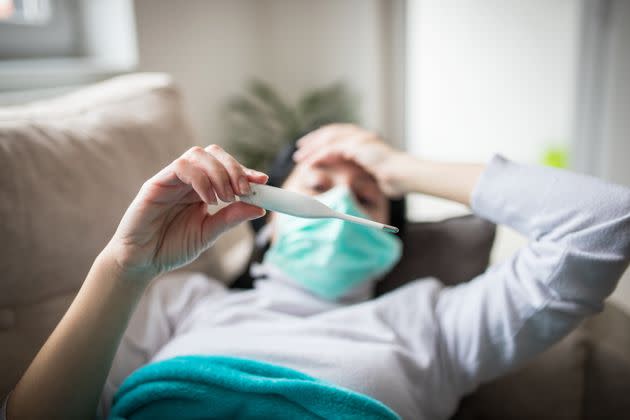Why Do Some People Get COVID But Others In The House Don't?

When I caught COVID right before Christmas — a breakthrough infection I got despite being vaccinated, boosted and wearing a medical-grade mask just about everywhere I went — I resigned myself to the fact that my kids would get it, too. We live in a tiny New York City apartment, after all. And my younger child is too young to be vaccinated.
But we tested them frequently throughout my quarantine, and after 10 days I hadn’t spread it to either of my kids or my husband. This has caused some people in my life to question whether I really had COVID-19 after all. (I’m going to believe the, like, seven at-home rapid tests that told me I did.)
But it’s also made me wonder a lot about the mysteries of COVID spread within households and how that has changed because of omicron. Many people fighting infections are also dealing with the same phenomenon.
Video: WHO says global COVID-19 case counts down 17%
Here’s what experts have to say about household COVID spread right now:
Omicron is more likely to spread within households than previous variants
Estimates suggest the initial omicron variant is up to four times more transmissible than previous COVID variants — and the newest omicron subvariant (BA.2) may be even more contagious than that. That seems to track within households as well. In early December, British health officials estimated that the risk of spreading omicron within a household was three times higher than with the delta variant.
With all of the variants, households pose a big risk just because of how much time you’re spending around those people.
“There are a lot of high-touch surfaces that might not get cleaned frequently. You might interact directly with saliva more frequently, especially if you have little kids. You’re probably not masking at home, so sitting next to each other on the couch you could easily get a spray of the bigger droplets in your face,” explained Alex Huffman, an aerosol scientist with the University of Denver.
“But, most importantly, your exposure to inhaled virus is likely much higher at home,” Huffman said. A lot of that has to do with ventilation.
“Many apartments and houses have pretty low air-exchange rates, so the air doesn’t get refreshed very often, and air that an infected person breathes out can build up to fairly high concentrations,” he said.
That said, household spread is not inevitable
One of the many reasons why health experts really hate the idea of just “getting omicron over with” ― aside from the fact that even “mild” COVID can feel really bad and that long-haul symptoms are a real risk ― is that it is by no means inevitable that you’ll get infected just because someone else in your family or home is sick.
“It’s very difficult to compare one study against the next. In general, early on in COVID, it was roughly found that between 10 to 20% of household exposures would end up with COVID, and that was pre-vaccine,” said Dr. Richard Martinello, an associate professor of infectious diseases and pediatrics at Yale School of Medicine. Other studies have put the secondary attack rate (i.e., the spread of the disease within a household or dwelling) a bit higher — more like 25% or 30%.
With omicron, those rates are likely higher. But again, it is by no means inevitable. Martinello pointed to a recent study from Denmark — which has not yet been subject to peer review — that suggests that with BA.2, a little over 40% of household contacts became infected themselves. With BA.1 (the initial omicron strain), it was more like 30%.
Basic prevention makes a big difference
There are a lot of factors that determine how likely household spread is, which is one issue that makes precise estimates of that type of transmission so challenging.
For one, some people shed more of the virus than others. People who are immunocompromised, for example, tend to have more severe, long-lasting infections. That means they’re likely to shed the virus for a longer period of time. Then there are other elements, like whether everyone in your home is vaccinated. The fact that my unvaccinated preschooler never got COVID when I had it makes me question whether he had an asymptomatic infection at some prior point that we never knew about that gave him some level of immunity, but I have no evidence of that. Also, antibody tests can be unreliable.
No matter your family or household’s specific circumstances, prevention can make a big difference in stopping the spread at home. To the extent it is possible, you should still isolate within your own home. (I fully admit that I gave up on this quest when I was sick myself because it was Christmas and also because there are only so many places you can hide from a zealous 3-year-old in an 800-square-foot home.)
“If the sick person can’t be fully isolated, I would suggest keeping as much distance as possible; wearing high-quality, tight-fitting masks (i.e., N95s); opening windows when you can; adding a couple portable air filters (like commercial HEPA filters or DIY Corsi-Rosenthal boxes); and limiting the time you spend in shared areas together,” Huffman said.
And be strategic about the time you spend together, he added.
“If possible, make sure you eat and drink in separate areas where the air can be ventilated or filtered more quickly,” he said, because any time the masks come off, the risk is highest.
Experts are still learning about COVID-19. The information in this story is what was known or available as of publication, but guidance can change as scientists discover more about the virus. Please check the Centers for Disease Control and Prevention for the most updated recommendations.
This article originally appeared on HuffPost and has been updated.




